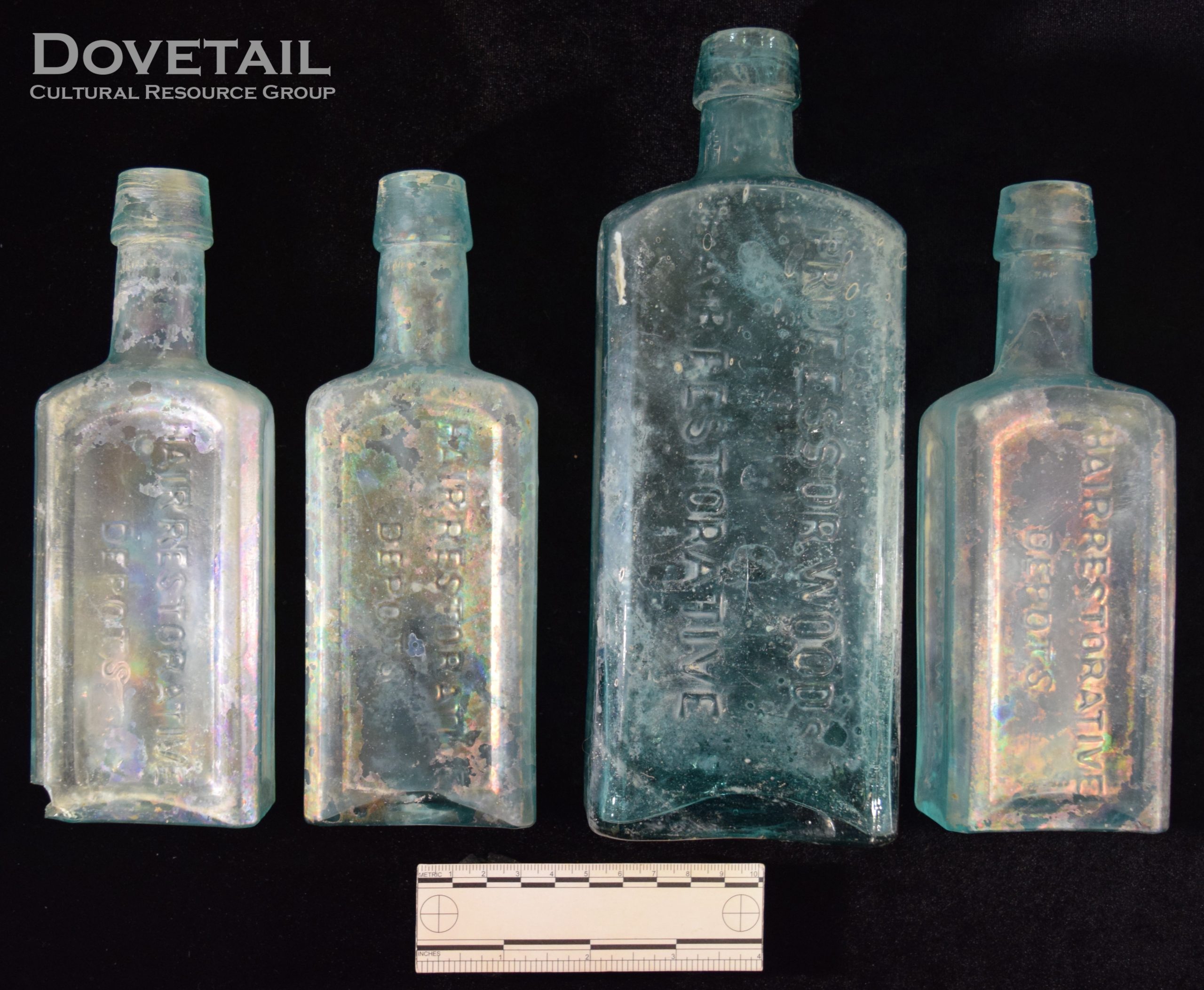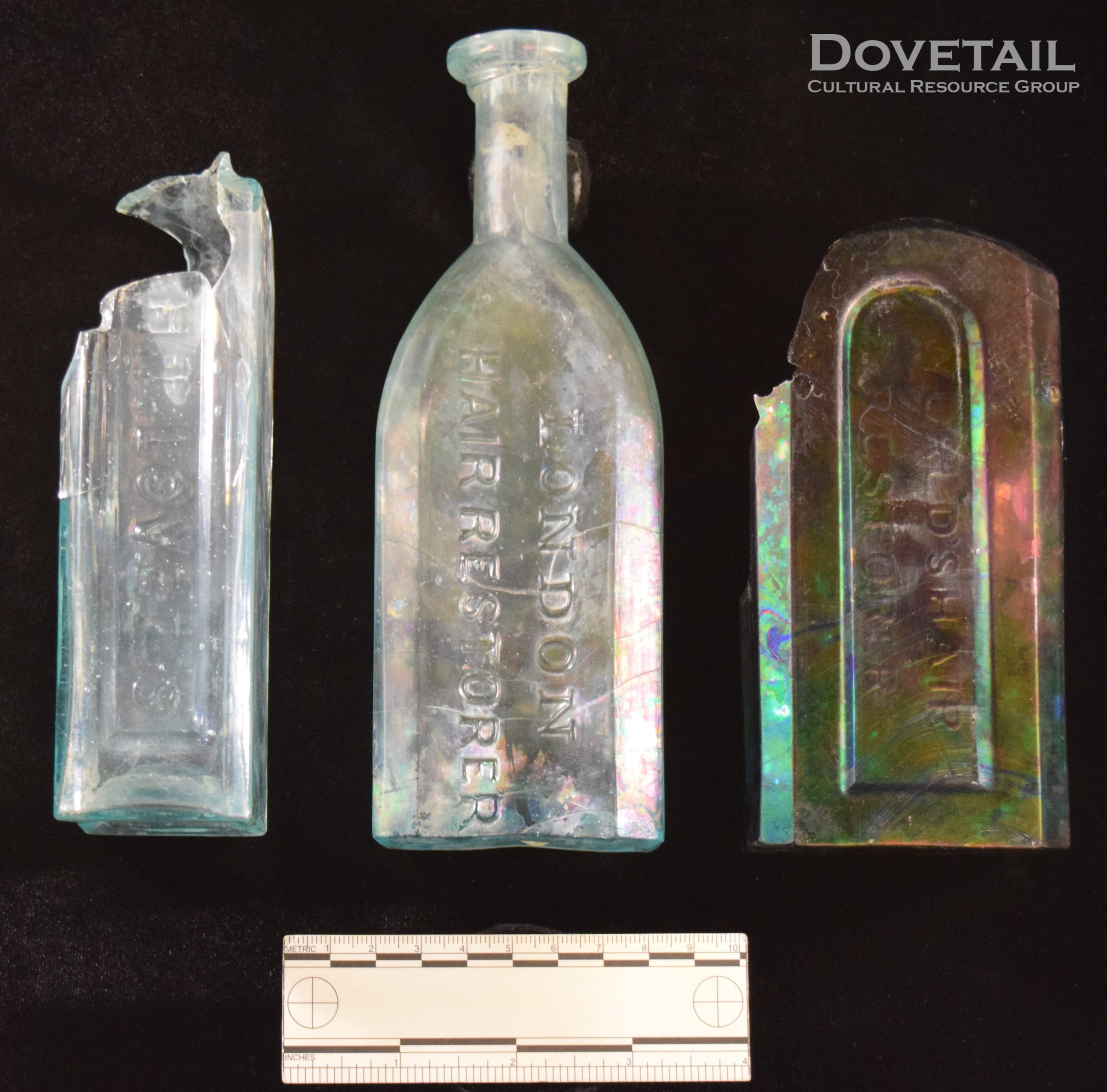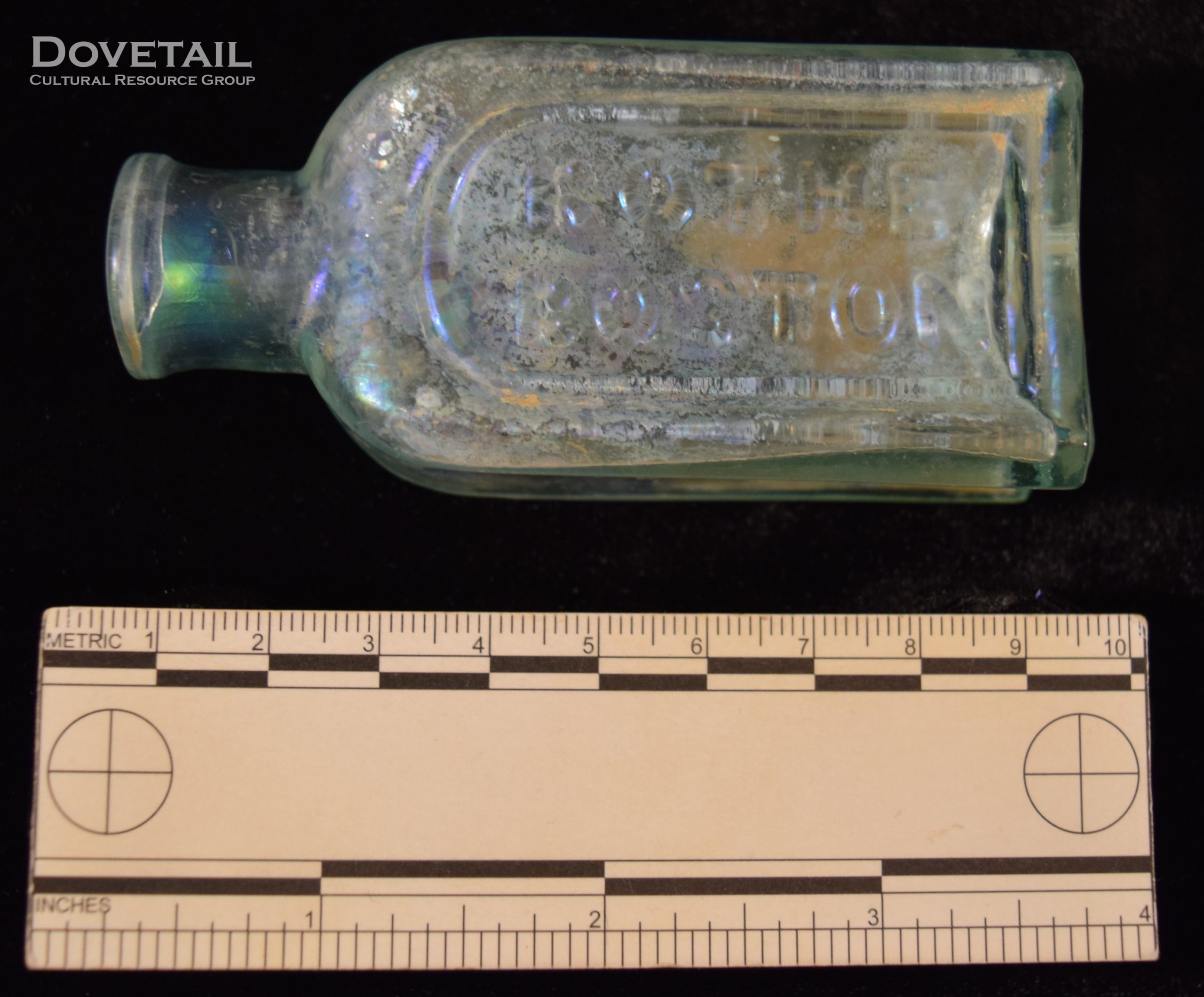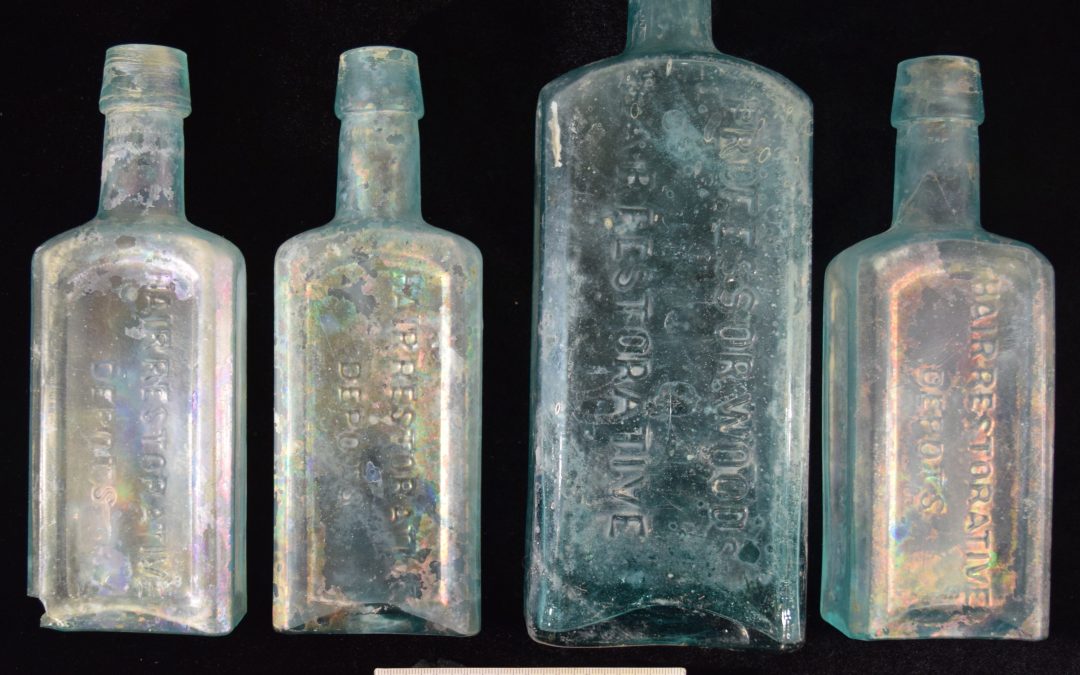By Lee Priddy and Bill Liebeknecht
The start of the 19th century saw the transition from powdered wigs as the fashionable hair accessory to flawlessly groomed, short hairstyles for men. The popularity of neatly trimmed hair and facial hair, the preference for brown and black coloring instead of naturally aging gray and white hair, and the desire for a thick head of hair with little sign of thinning and balding, continued to rise into the late-19th century Victorian era. As a result, multiple individuals and companies created, and increasingly marketed, hair restorative and hair dye products for consumers (American Battlefield Trust 2020: Ancientspast 2023; Barber 2022; Grove nd).
The consumers of the hair products, though, often did not want others to realize their need for such products, and the disposal of these bottles was sometimes done covertly to hide where few might see or find them. Where was a good place to hide them? A privy. Recent archaeological excavations at the Buena Vista privy (outhouse) in New Castle, Delaware, conducted by Dovetail recovered eight, whole and partial bottles related to hair restoration and hair dyes at the bottom of the privy (Liebeknecht et al. 2023). These bottles date from the 1850s and 1860s and were purposefully disposed of in the brick-lined privy shaft. Subsequent historic cleanouts of the privy during its use could not reach the lower level; as such these bottles were preserved in place. What can these bottles tell us about life at Buena Vista during this time period?
What Were Their Purpose?
Seven of the bottles were purposefully branded as hair restoration tonics as noted on embossed (raised) lettering on the bottles themselves and in surviving advertisements from the time period. Four bottles were from the same company—Professor Woods/Hair Restoration Depots manufactured in both St. Louis, Missouri, and New York—dating between 1852 and 1860 (Photo 1). Professor Woods claimed that his product “is the only Preparation which will in all cases Restore Gray Hair TO ITS ORIGINAL COLOR” (Fadely 2013a). The other three bottles were from three different manufacturers and were recovered just above the Professor Woods bottles stratigraphically in the privy fill and were thus used more recently. These bottles consist of a H.T. Lovet’s Wahpene, a London Hair Restorer, and Mrs. S.A. Allen’s World Hair Restorer (Photo 2).


Hezekiah T. Lovet was selling his “Wahpene” in New York from 1853 until at least 1861. Wahpene was advertised to be an “Indian” vegetable preparation that never failed to change grey hair to its youthful appearance and also cured baldness (Fadely 2013b). The “LONDON HAIR RESTORER” bottle was one of the products created by Dr. Huson Swayne & Son of Philadelphia. They began to advertise their London Hair Restorer in 1860 and promised to restore hair to its natural color (Fadely 2013c). The dark purple bottle of Mrs. S.A. Allen’s/World Hair Restorer with an embossed address of 355 Broome Street in New York dates to after 1854. Her advertisements also detailed that gray hair would be reverted to its original color. Her hair restorer came in two colors —one for light hair and one dark hair (Fadely 2013d).
The eighth bottle was found alongside the Professor Woods bottles and was specifically advertised as hair dye, not a hair restorative (Photo 3). Charles Rothe, a German immigrant, was selling dye at least as early as 1850. His bottle found at Buena Vista, One Roth Boston No 1, contained black hair dye (Fadely 2013e).

Who lived at Buena Vista that Could be Hiding the Bottles in the Privy?
Senator John M. Clayton constructed his new residence named Buena Vista in New Castle, Delaware by April 1847. Clayton served as a U.S. Senator, Delaware chief justice, and secretary of state under President Zachary Taylor from 1849 to 1850. On February 7, 1853, the childless Senator Clayton conveyed Buena Vista and the surrounding lands to his nephew, James C. Douglass. Clayton continued to live there until his death in 1856 (Saving Delaware History nd).
James Douglass, his wife Ellen Sinclair, and their two children, Margaret and Clayton, resided at Buena Vista beginning in 1853 with his uncle still in residence as well. Ellen died in 1854, and Clayton passed away before adulthood in 1872. In 1875, James Douglass died and left his only surviving child, Margaret, the estate (Saving Delaware History nd).
Between 1847 and 1876, there were only two gentlemen who owned Buena Vista—Senator John Clayton and James Douglass. Senator Clayton’s wife passed away before the construction of Buena Vista and Douglass’s wife, Ellen, died the following year after moving to the estate. Based on this information, the bottles were unlikely to have been associated with any women of the household (Saving Delaware History nd).
At this point, there is not enough data to determine whether it was Clayton or Douglas who was using these hygiene products. Perhaps the answer lies within nearby archaeological deposits in the privy. Additional excavations may answer the question of who was using the nineteenth- century version of today’s Just for Men….
References
American Battlefield Trust
2020 The Rise and Fall of the Powdered Wig. Head-Tilting History. Electronic document, https://www.battlefields.org/learn/head-tilting-history/rise-and-fall-powdered-wig, accessed November 2023.
Ancientspast
2023 Exploring the History of Hair Dye in the Victorian Era. Electronic document, https://ancientspast.com/exploring-the-history-of-hair-dye-in-the-victorian-era/, accessed November 2023.
Barber, Anthony
2022 5 Exclusive Victorian Hairstyles for True Gentlemen Vie. Beardoholic. Electronic Document, https://beardoholic.com/victorian-hairstyles-men/#:~:text=Men%E2%80%99s%20hairstyles%20were%20mostly%20shaped%20by%20the%20traditional,side%20part%20haircuts%2C%20slicked-back%20hairstyles%20and%20long%20sideburns, accessed November 2023.
Fadely, Don
2013a Hair Raising Stories – Wood’s (Professor) Hair Restorative. Electronic document, http://www.hairraisingstories.com/Products/WOOD_HR.html, accessed November 2023.
2013b Hair Raising Stories – Lovet’s Wahpene. Electronic document, http://www.hair
raisingstories.com/Products/LOVET_W.html, accessed November 2023.
2013c Hair Raising Stories – London Hair Restorer. Electronic document, http://www.
hairraisingstories.com/Products/LONDON_HR.html, accessed November 2023.
2013d Hair Raising Stories – Mrs. Susan A. Allen. Electronic document, http://www.
hairraisingstories.com/Proprietors/ALLENSA.html, accessed November 2023.
2013e Hair Raising Stories – Rothe’s Hair Dye. Electronic document, http://www.hair
raisingstories.com/Products/ROTHE_HD.html, accessed November 2023.
Grove, Stephen
nd The Distinguished Styles: Men’s 19th Century Hairstyles and Grooming Trends. 19th Century Events and Developments. Electronic document, https://19thcentury.us/19th-century-hairstyles-men/, accessed November 2023.
Liebeknecht, Bill, Lee Priddy, and Jessica Miller
2023 Phase II Archaeological Studies on the Summer House Privies at Buena Vista, 7NC-E-145, New Castle County, Delaware. Dovetail Cultural Resource Group, Fredericksburg, Virginia.
Saving Delaware History
Nd Buena Vista- A Brief History. Document Control # 20-06-11-03-01. Electronic Document, https://buenavista.delaware.gov/wp-content/uploads/sites/12/2016/09/BuenaVista_history_2011.pdf, accessed November 2023.

